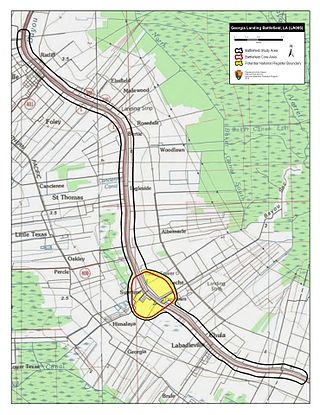
The American Civil War saw extensive use of horse-mounted soldiers on both sides of the conflict. They were vital to both the Union Army and Confederate Army for conducting reconnaissance missions to locate the enemy and determine their strength and movement, and for screening friendly units from being discovered by the enemy's reconnaissance efforts. Other missions carried out by cavalry included raiding behind enemy lines, escorting senior officers, and carrying messages.
This is a list of Confederate government Civil War military units, not raised by any state.

The Battle of Rowlett's Station was a land battle in the American Civil War, fought at the railroad whistle-stop of Rowlett's in Hart County, Kentucky, on December 17, 1861. The outcome was inconclusive, although the Union Army continued to hold its objective, a railroad bridge across the Green River.

The Colorado Territory was formally created in 1861 shortly before the bombardment of Fort Sumter sparked the American Civil War. Although sentiments were somewhat divided in the early days of the war, Colorado was only marginally a pro-Union territory. Colorado was strategically important to both the Union and Confederacy because of the gold and silver mines there as both sides wanted to use the mineral wealth to help finance the war. The New Mexico Campaign was a military operation conducted by Confederate Brigadier General Henry Sibley to gain control of the Southwest, including the gold fields of Colorado, the mineral-rich territory of Nevada and the ports of California. The campaign was intended as a prelude to an invasion of the Colorado Territory and an attempt to cut the supply lines between California and the rest of the Union. However, the Confederates were defeated at the Battle of Glorieta Pass in New Mexico and were forced to retreat back to Texas, effectively ending the New Mexico Campaign.

The Battle of Georgia Landing or Battle of Labadieville was fought between a Union Army force led by Brigadier General Godfrey Weitzel and a Confederate States Army force commanded by Brigadier General Alfred Mouton near Labadieville, Assumption Parish, Louisiana, during the American Civil War. After a sharp clash, the Union troops compelled Mouton's outnumbered force to retreat.

The 18th Virginia Cavalry Regiment was a cavalry regiment raised in Virginia for service in the Confederate States Army during the American Civil War. It fought with the Army of Northern Virginia, in southwest Virginia, and in the Shenandoah Valley.
The 3d Arkansas Cavalry Regiment (1861–1865) was a Confederate Army Cavalry regiment during the American Civil War.

The 11th Arkansas Infantry Regiment or 11th Arkansas Volunteers was an infantry formation of the Confederate States Army during the American Civil War. Following the units surrender during the Battle of Island No. 10, it was consolidated with Griffith's 17th Arkansas Infantry Regiment and mounted. Following the surrender of Port Hudson, some unit members returned to Arkansas and became part of Poe's Arkansas Cavalry Battalion and Logan's 11th Arkansas Cavalry Regiment.
The following list is a bibliography of American Civil War Confederate military unit histories and are generally available through inter-library loan. More details on each book are available at WorldCat. For an overall national view, see Bibliography of the American Civil War. For histories of the Union, see Bibliography of American Civil War Union military unit histories. For a guide to web sources see: Carter, Alice E.; Jensen, Richard. The Civil War on the Web: A Guide to the Very Best Sites—Completely Revised and Updated (2003).
The Mississippi State Troops were military units formed by the Mississippi Legislature for State defense during the American Civil War. Five infantry regiments, four infantry battalions, and one cavalry battalion were drafted from the Mississippi militia in 1862. Two of the infantry regiments participated in the 1863 siege of Vicksburg, and several State Troop cavalry units were later reorganized and brought into Confederate service. However, most of the State Troop units were kept in military camps and never saw combat. In 1864, another set of State Troop units was created, with all white men aged 16–55 required to report for 30 days military service. Reserve State Troop units were also organized in 1864, consisting of men and boys who were otherwise too young or too old for regular military service. All of the remaining State Troops were officially disbanded when Confederate Lieutenant-General Richard Taylor surrendered all Confederate forces in the Department of Alabama, Mississippi, and East Louisiana to United States authorities on May 4, 1865, at Citronelle, Alabama.







